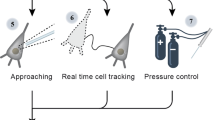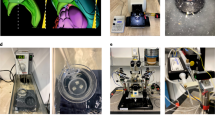Abstract
In neuroscience, combining patch-clamping with protein identification in the same cell is becoming increasingly important to define which subtype or developmental stage of a neuron or glial cell is being recorded from, and to attribute measured membrane currents to expressed ion channels or receptors. Here, we describe a protocol to achieve this when studying cells in acute brain slices, which antibodies penetrate poorly into and for which detergent permeabilization cannot be used when using antibodies that recognize lipid components such as O4 sulfatide. The method avoids the need for resectioning of the electrophysiologically recorded slices. It employs filling of the cell with a fluorescent dye during whole-cell recording, to allow subsequent localization of the cell, followed by fixation and free-floating section labeling with up to three antibodies, which may recognize membrane, nuclear or cytosolic proteins. With practice, ∼80% of patch-clamped cells can be retrieved and have their proteins identified in this way. The entire protocol can be completed in 3–4 d.
This is a preview of subscription content, access via your institution
Access options
Subscribe to this journal
Receive 12 print issues and online access
$259.00 per year
only $21.58 per issue
Buy this article
- Purchase on Springer Link
- Instant access to full article PDF
Prices may be subject to local taxes which are calculated during checkout





Similar content being viewed by others
References
Gupta, A., Wang, Y. & Markram, H. Organizing principles for a diversity of GABAergic interneurons and synapses in the neocortex. Science 287, 273–278 (2000).
Somogyi, P. & Klausberger, T. Defined types of cortical interneurone structure space and spike timing in the hippocampus. J. Physiol. 562, 9–26 (2005).
Jessell, T.M. & Sanes, J.R. The decade of the developing brain. Curr. Opin. Neurobiol. 10, 599–611 (2000).
Deloulme, J.C. et al. Nuclear expression of S100β in oligodendrocyte progenitor cells correlates with differentiation toward the oligodendroglial lineage and modulates oligodendrocytes' maturation. Mol. Cell. Neurosci. 27, 453–465 (2004).
Grateron, L. et al. Postnatal development of calcium-binding proteins immunoreactivity (parvalbumin, calbindin, calretinin) in the human entorhinal cortex. J. Chem. Neuroanat. 26, 311–316 (2003).
Gurantz, D., Lautermilch, N.J., Watt, S.D. & Spitzer, N.C. Sustained upregulation in embryonic spinal neurons of a Kv3.1 potassium channel gene encoding a delayed rectifier current. J. Neurobiol. 42, 347–356 (2000).
Ullensvang, K., Lehre, K.P., Storm-Mathisen, J. & Danbolt, N.C. Differential developmental expression of the two rat brain glutamate transporter proteins GLAST and GLT. Eur. J. Neurosci. 9, 1646–1655 (1997).
Liu, X.B., Murray, K.D. & Jones, E.G. Switching of NMDA receptor 2A and 2B subunits at thalamic and cortical synapses during early postnatal development. J. Neurosci. 24, 8885–8895 (2004).
Van Gelder, R.N., von Zastrow, M.E., Yool, A., Dement, W.C., Barchas, J.D. & Eberwine, J.H. Amplified RNA synthesized from limited quantities of heterogeneous cDNA. Proc. Natl. Acad. Sci. USA 87, 1663–1667 (1990).
Surmeier, D.J., Eberwine, J., Wilson, C.J., Cao, Y., Stefani, A. & Kitai, S.T. Dopamine receptor subtypes colocalize in rat striatonigral neurons. Proc. Natl. Acad. Sci. USA 89, 10178–10182 (1992).
Lambolez, B., Audinat, E., Bochet, P., Crepel, F. & Rossier, J. AMPA receptor subunits expressed by single Purkinje cells. Neuron 9, 247–258 (1992).
Jonas, P., Racca, C., Sakmann, B., Seeburg, P.H. & Monyer, H. Differences in Ca2+ permeability of AMPA-type glutamate receptor channels in neocortical neurons caused by differential GluR-B subunit expression. Neuron 12, 1281–1289 (1994).
Guyon, A., Laurent, S., Paupardin-Tritsch, D., Rossier, J. & Eugene, D. Incremental conductance levels of GABAA receptors in dopaminergic neurones of the rat substantia nigra pars compacta. J. Physiol. 516, 719–737 (1999).
Ikawa, M., Kominami, K., Yoshimura, Y., Tanaka, K., Nishimune, Y. & Okabe, M. Green fluorescent protein as a marker in transgenic mice. Dev. Growth Differ. 37, 455–459 (1995).
Zhuo, L., Sun, B., Zhang, C.-L., Fine, A., Chiu, S.-Y. & Messing, A. Live astrocytes visualised by green fluorescent protein in transgenic mice. Dev. Biol. 187, 36–42 (1997).
Mallon, B.S., Shick, H.E., Kidd, G.J. & Macklin, W.B. Proteolipid promoter activity distinguishes two populations of NG2-positive cells throughout neonatal cortical development. J. Neurosci. 22, 876–885 (2002).
Yuan, X., Chittajallu, R., Belachew, S., Anderson, S., McBain, C.J. & Gallo, V. Expression of the green fluorescent protein in the oligodendrocyte lineage: a transgenic mouse for developmental and physiological studies. J. Neurosci. Res. 70, 529–545 (2002).
Heintz, N. BAC to the future: the use of bac transgenic mice for neuroscience research. Nat. Rev. Neurosci. 2, 861–870 (2001).
Monyer, H. & Markram, H. Molecular and genetic tools to study GABAergic interneuron diversity and function. Trends Neurosci. 27, 90–97 (2004).
Kawaguchi, Y. & Kubota, Y. Correlation of physiological subgroupings of nonpyramidal cells with parvalbumin- and calbindinD28k-immunoreactive neurons in layer V of rat frontal cortex. J. Neurophysiol. 70, 387–396 (1993).
Bergles, D.E., Roberts, J.D., Somogyi, P. & Jahr, C.E. Glutamatergic synapses on oligodendrocyte precursor cells in the hippocampus. Nature 405, 187–191 (2000).
Chittajallu, R., Aguirre, A. & Gallo, V. NG2-positive cells in the mouse white and grey matter display distinct physiological properties. J. Physiol. 561, 109–122 (2004).
Káradóttir, R., Cavelier, P., Bergersen, L.H. & Attwell, D. NMDA receptors are expressed in oligodendrocytes and activated in ischaemia. Nature 438, 1162–1166 (2005).
Sakmann, B. & Stuart, G. Patch-pipette recordings from the soma, dendrites, and axon of neurons in brain slices. in Single-Channel Recording 2nd edn. (eds. Sakmann, B. and Neher, E.) 199–211 (Plenum, New York, 1995).
Gibb, A.J. Patch-clamp recording. in Ion Channels: A Practical Approach (ed. Ashley, R.H.) 1–27 (Oxford University Press, Oxford, 1995).
Paxinos, G. & Watson, C. in The Rat Brain in Stereotaxic Coordinates Plates 15 and 45 (Academic Press, Sydney, Australia, 1982).
Holmseth, S., Lehre, K.P. & Danbolt, N.C. Specificity controls for immunocytochemistry. Anat. Embryol. (Berl.), 211, 257–266 (2006).
Jiao, Y. et al. A simple and sensitive antigen retrieval method for free-floating and slide-mounted tissue sections. J. Neurosci. Methods 93, 149–162 (1999).
Acknowledgements
We thank D. Rowitch, C.D. Stiles & J. Alberta for Olig2 antibody; W. Stallcup for NG2 antibody; F.A. Stephenson, R.J. Wenthold & O.P. Ottersen for NR1 antibody; and W. Andrews, M. Catsicas, I. Hans, K. Jessen, R. Mirsky, P. Mobbs, S. Rakic and W. Richardson for advice. Funded by the Wellcome Trust grant number 075232.
Author information
Authors and Affiliations
Corresponding author
Ethics declarations
Competing interests
The authors declare no competing financial interests.
Rights and permissions
About this article
Cite this article
Káradóttir, R., Attwell, D. Combining patch-clamping of cells in brain slices with immunocytochemical labeling to define cell type and developmental stage. Nat Protoc 1, 1977–1986 (2006). https://doi.org/10.1038/nprot.2006.261
Published:
Issue Date:
DOI: https://doi.org/10.1038/nprot.2006.261
This article is cited by
-
Neuroimaging of Supraventricular Frontal White Matter in Children with Familial Attention-Deficit Hyperactivity Disorder and Attention-Deficit Hyperactivity Disorder Due to Prenatal Alcohol Exposure
Neurotoxicity Research (2021)
-
Investigating the influence of perinatal nicotine exposure on genetic profiles of neurons in the sub-regions of the VTA
Scientific Reports (2020)
-
Pneumonia-induced endothelial amyloids reduce dendritic spine density in brain neurons
Scientific Reports (2020)
-
Reduced glutamate in white matter of male neonates exposed to alcohol in utero: a 1H-magnetic resonance spectroscopy study
Metabolic Brain Disease (2016)
-
Neuronal activity regulates remyelination via glutamate signalling to oligodendrocyte progenitors
Nature Communications (2015)
Comments
By submitting a comment you agree to abide by our Terms and Community Guidelines. If you find something abusive or that does not comply with our terms or guidelines please flag it as inappropriate.



